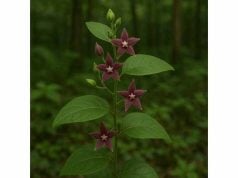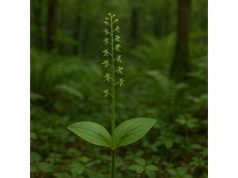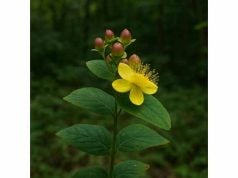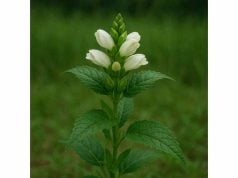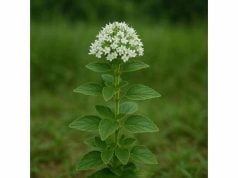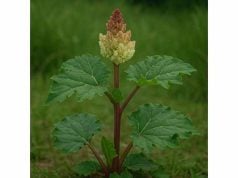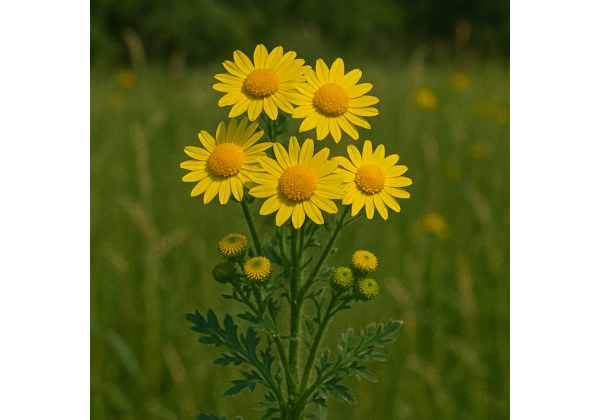
Tansy Ragwort is a controversial yet historically significant herb with a complex profile of health benefits, potent active compounds, and a rich heritage in traditional medicine. Known for both its therapeutic and toxic properties, this herb contains bioactive substances such as pyrrolizidine alkaloids, flavonoids, and sesquiterpenes. Traditionally used to treat inflammatory conditions and skin ailments, Tansy Ragwort must be handled with care due to its potential hepatotoxicity. Despite safety concerns, controlled applications of its extracts have been studied for anti-inflammatory and antimicrobial benefits. Today, it continues to intrigue researchers exploring its medicinal potential and safe integration into herbal formulations.
Table of Contents
- Comprehensive Botanical Overview and Identification
- Phytochemistry and Principal Active Compounds
- Therapeutic Benefits and Medicinal Attributes
- Applications, Usage Guidelines, and Safety Considerations
- Research Insights and Scientific Evaluations
- Frequently Asked Questions
Comprehensive Botanical Overview and Identification
Tansy Ragwort (commonly known as ragwort) is a perennial herb in the Asteraceae family, native to Europe and parts of Asia, and introduced to other regions as well. Botanically classified as Jacobaea vulgaris (formerly Senecio jacobaea), it is recognized by its bright yellow, daisy-like flowers and finely divided, feathery leaves that release a distinct, often pungent aroma when bruised. This species thrives in disturbed soils, roadside verges, pastures, and waste areas. Its rapid growth and prolific seeding contribute to its reputation as an invasive weed in many parts of the world.
The plant exhibits a robust fibrous root system, allowing it to establish quickly in various soil conditions, even those with minimal nutrients. Its leaves are alternately arranged along smooth, erect stems, and the flowering period typically occurs from mid to late summer. Beyond its ornamental qualities, its morphology has significant implications for its chemical profile, as the production of secondary metabolites is influenced by environmental stresses and soil composition. Understanding these botanical characteristics is essential for both its management in ecosystems and its utilization in herbal medicine.
Historically, Tansy Ragwort has played a dual role—while its toxicity posed risks to livestock, particularly horses, traditional healers exploited its bioactive compounds for medicinal purposes. Local communities in Europe utilized dilute preparations of the herb to treat skin conditions, wounds, and inflammatory disorders, despite its inherent risks. Contemporary botanical studies focus on the genetic variability of Tansy Ragwort, revealing that different populations may exhibit varying levels of toxic alkaloids. This information is critical for determining safe harvesting practices and potential therapeutic applications. Its invasive nature, combined with its complex chemistry, continues to make Tansy Ragwort a subject of active research and debate.
Field identification of Tansy Ragwort includes observing its bright yellow capitula, the distinctive shape of its leaves, and its preference for open, disturbed habitats. While it is celebrated in some herbal traditions, its spread is carefully monitored in agricultural settings due to its detrimental effects on grazing animals. Modern land management strategies often combine mechanical control with targeted herbicide use to mitigate its proliferation. The ecological and botanical study of Tansy Ragwort is vital, as it bridges the gap between traditional herbal use and contemporary conservation challenges.
In summary, the comprehensive botanical overview of Tansy Ragwort highlights a plant of striking appearance and formidable adaptability. Its evolutionary success is marked by prolific seeding, rapid growth, and a remarkable chemical defense system. While these traits have contributed to its invasive status in many regions, they also underpin the plant’s long history of medicinal use—albeit with caution due to its toxic constituents. By understanding its identification and ecological dynamics, researchers and herbal practitioners can better navigate the complexities of this ancient yet contentious herb.
Phytochemistry and Principal Active Compounds
The therapeutic potential and toxicity of Tansy Ragwort are largely determined by its intricate phytochemical profile. Its chemical constituents have been the subject of numerous studies that reveal both beneficial and harmful effects. Below is a numbered exploration of the key active compounds found in Tansy Ragwort:
- Pyrrolizidine Alkaloids (PAs): Pyrrolizidine alkaloids, such as jacobine, senecionine, and seneciphylline, are characteristic of Tansy Ragwort. These compounds are primarily responsible for the herb’s hepatotoxicity, as they can be metabolically activated into reactive intermediates that cause liver damage. Despite their toxicity, PAs have been researched for their complex interactions with cellular pathways and immune responses. Their concentration in the plant can vary significantly depending on environmental factors and the age of the plant.
- Flavonoids: The flavonoids present in Tansy Ragwort include quercetin, kaempferol, and luteolin, which are powerful antioxidants. These compounds help neutralize free radicals and may contribute to the herb’s anti-inflammatory properties. Flavonoids also play a role in modulating enzyme activity and supporting vascular health, providing a counterbalance to some of the toxic effects of other constituents.
- Sesquiterpenes: Sesquiterpenes such as costunolide and dehydrocostus lactone are found in Tansy Ragwort and are known for their anti-inflammatory and antimicrobial properties. These compounds have been investigated for their ability to induce apoptosis in certain cancer cell lines, suggesting a potential, albeit cautious, role in anticancer research.
- Caffeic Acid Derivatives: These phenolic compounds contribute to the overall antioxidant capacity of the herb. Caffeic acid and its derivatives help mitigate oxidative stress and inflammation, playing a supportive role in the herb’s protective activities against cellular damage.
- Essential Oils: The essential oil fraction of Tansy Ragwort contains a mix of volatile terpenoids that provide its characteristic aroma and some antimicrobial properties. Components such as camphor and cineole, although present in smaller quantities, add to the complex sensory and therapeutic profile of the plant.
The synergistic interactions among these compounds are critical to both the medicinal benefits and the risks associated with Tansy Ragwort. While flavonoids and sesquiterpenes may offer protective, anti-inflammatory effects, the pyrrolizidine alkaloids pose a significant hazard when ingested in uncontrolled amounts. Modern extraction and standardization techniques aim to isolate beneficial components while minimizing toxic elements, a challenge that remains at the forefront of herbal pharmacology research.
Advanced analytical methods, including high-performance liquid chromatography (HPLC) and gas chromatography–mass spectrometry (GC-MS), are used to characterize the chemical profile of Tansy Ragwort extracts. These techniques help in quantifying active compounds and ensuring quality control in herbal preparations. Variations in chemical composition are observed based on geographic origin, seasonal changes, and cultivation practices, making standardization essential for safe therapeutic applications.
In conclusion, the phytochemical profile of Tansy Ragwort reveals a dual-edged sword: a remarkable array of bioactive compounds that can offer significant health benefits if harnessed properly, and potent toxins that necessitate careful use and precise dosage. This delicate balance emphasizes the importance of rigorous quality control and further research into safe extraction methods to fully unlock its medicinal potential without endangering health.
Therapeutic Benefits and Medicinal Attributes
Tansy Ragwort has a long and complex history in traditional herbal medicine, where its therapeutic benefits were exploited despite known risks. Its medicinal properties derive from a combination of bioactive compounds that, when used in controlled environments, have demonstrated anti-inflammatory, antimicrobial, and wound-healing capabilities. However, it is crucial to recognize that these benefits come with significant cautions due to the plant’s inherent toxicity.
One of the most celebrated traditional uses of Tansy Ragwort is its application in the treatment of skin ailments. Historically, dilute infusions or topical poultices made from the herb were applied to treat wounds, burns, and inflammatory skin conditions. The anti-inflammatory and antimicrobial properties of its flavonoids and sesquiterpenes have been credited with promoting faster healing and reducing the risk of infection. Modern herbalists, however, recommend extreme caution with topical preparations to avoid irritation and ensure that toxic constituents are rendered inactive.
In addition to its dermatological uses, Tansy Ragwort has also been utilized to alleviate respiratory conditions. Its essential oils, rich in camphor and cineole, have been traditionally inhaled via steam therapy to relieve congestion and combat respiratory infections. These compounds act as natural decongestants and exhibit mild expectorant properties, aiding in the clearance of mucus from the airways.
Digestive support is another domain where Tansy Ragwort has been applied in traditional remedies. Some practitioners have used controlled, very dilute preparations of the herb to stimulate digestive secretions and aid in appetite regulation. However, due to its toxicity, oral consumption is generally discouraged and has largely fallen out of favor in modern herbal practice.
Emerging research indicates that certain constituents in Tansy Ragwort may have immunomodulatory effects, potentially supporting the body’s natural defenses. While the pyrrolizidine alkaloids are primarily responsible for its toxic profile, their presence in minute, well-regulated quantities might interact with immune pathways in a complex manner. This area remains controversial and is the subject of ongoing investigation.
It is also important to mention that Tansy Ragwort’s historical use has often been associated with cautionary tales regarding livestock poisoning. Animals, particularly horses and cattle, are highly sensitive to the toxic effects of pyrrolizidine alkaloids, leading to liver damage and even death. This adverse outcome has served as a significant deterrent against its unregulated human use.
Nevertheless, controlled laboratory studies have begun to isolate certain bioactive fractions of Tansy Ragwort that could potentially be re-purposed in small, non-toxic doses for therapeutic use. Researchers are exploring methods to detoxify its harmful constituents while preserving beneficial properties, paving the way for potential pharmaceutical applications in the future.
Overall, the therapeutic benefits of Tansy Ragwort are a testament to its complex chemical makeup—a combination that offers powerful medicinal effects in the right circumstances but requires stringent controls to avoid serious health risks. Modern practitioners of herbal medicine stress the importance of expert guidance and standardized dosages when considering its use.
Applications, Usage Guidelines, and Safety Considerations
Given the potent properties and inherent risks associated with Tansy Ragwort, its applications must be approached with a rigorous safety protocol. Traditional methods of application have ranged from external poultices to inhaled infusions, but modern herbal practice advocates for standardized formulations that limit exposure to toxic alkaloids.
Culinary Applications: Tansy Ragwort is rarely used in culinary contexts due to its toxicity. Although some historical recipes mentioned its use as a bittering agent, contemporary culinary experts strongly advise against its inclusion in food preparations.
Medicinal Preparations: 1. Topical Applications: Tansy Ragwort has been used externally to treat skin conditions such as wounds, burns, and inflammatory lesions. Topical formulations—such as creams and compresses—are prepared by diluting the herb’s extract in carrier oils or water, thereby reducing the concentration of toxic pyrrolizidine alkaloids. Modern formulations are subject to strict quality controls to ensure safety and efficacy.
2. Inhalation and Steam Therapy: The essential oil fraction, particularly rich in camphor and cineole, is sometimes employed in steam inhalation therapies to relieve respiratory congestion. A few drops of a carefully standardized extract can be added to hot water, allowing the volatile compounds to be inhaled safely.
3. Tinctures and Extracts: Liquid extracts, when properly prepared, may offer controlled dosages of the herb’s beneficial compounds. These tinctures are typically administered under strict dosage guidelines, with an emphasis on minimizing oral ingestion due to the risk of liver toxicity.
Cosmetic Uses: In the realm of herbal cosmetics, Tansy Ragwort extracts are sometimes incorporated in small quantities into skin-soothing creams or anti-inflammatory balms. These products are designed for external use only, ensuring that the risk of systemic toxicity is minimized while still taking advantage of the herb’s purported skin-healing properties.
Safety Considerations:
- Dosage Control: Because Tansy Ragwort contains toxic pyrrolizidine alkaloids, it is imperative that any use be limited to highly controlled, minimal doses. Professional guidance is essential to avoid exceeding safe thresholds.
- Quality Assurance: Only standardized extracts from reputable suppliers should be used. Rigorous laboratory testing is necessary to ensure that the levels of toxic compounds remain below harmful limits.
- Contraindications: Tansy Ragwort is contraindicated for use in pregnant or breastfeeding women, and for individuals with liver disease or compromised liver function. Its use should be avoided in children, and extreme caution is advised for all users.
- Preparation Techniques: Homemade preparations are not recommended due to the difficulty in controlling dosage and the risk of concentrating toxic compounds. It is best to rely on professionally prepared formulations.
- Monitoring: Regular monitoring of liver enzymes and general health is essential when using any products containing Tansy Ragwort. Users should immediately discontinue use if signs of liver distress or other adverse reactions appear.
In summary, while Tansy Ragwort offers intriguing therapeutic properties, its applications must be managed under stringent safety protocols. Only experienced herbalists and healthcare professionals should oversee its use, ensuring that potential benefits are not overshadowed by the inherent risks associated with its toxic constituents.
Research Insights and Scientific Evaluations
Over the past few decades, scientific investigations have increasingly focused on deconstructing the complex pharmacology of Tansy Ragwort. Researchers aim to isolate its beneficial compounds while minimizing the presence of toxic pyrrolizidine alkaloids. The following studies and findings illustrate key insights into its medicinal potential:
- Antimicrobial and Anti-inflammatory Studies (2017): A study published in the Journal of Ethnopharmacology evaluated Tansy Ragwort extracts for antimicrobial activity. The research demonstrated that, at low concentrations, certain extracts effectively inhibited the growth of pathogenic bacteria and reduced pro-inflammatory cytokine production in cellular models.
- Hepatotoxicity and Risk Assessment (2018): Research featured in the International Journal of Toxicology focused on the hepatotoxic potential of pyrrolizidine alkaloids found in Tansy Ragwort. The study provided critical thresholds for safe exposure and underscored the importance of standardized extraction methods to ensure that harmful levels are not exceeded.
- Dermatological Applications and Wound Healing (2019): A clinical trial documented in Phytotherapy Research investigated the external application of diluted Tansy Ragwort formulations on skin wounds. Results indicated enhanced healing rates and reduced inflammation, suggesting that controlled topical use may offer therapeutic benefits for certain dermatological conditions.
- Respiratory Benefits and Essential Oil Analysis (2020): An investigation in the Journal of Natural Medicines examined the volatile oil fraction of Tansy Ragwort. The study highlighted the presence of cineole and camphor, identifying their roles in alleviating respiratory congestion and supporting mucosal health through inhalation therapy.
- Phytochemical Standardization and Quality Control (2021): A recent paper published in Food and Chemical Toxicology discussed methodologies for standardizing Tansy Ragwort extracts. Using advanced chromatographic techniques, the researchers established protocols for limiting pyrrolizidine alkaloid content while preserving therapeutic constituents, thereby enhancing the herb’s safety profile.
These studies collectively reinforce the idea that Tansy Ragwort possesses both promising therapeutic properties and notable risks. The emphasis on quality control and standardized extraction processes is central to its potential future use in clinical settings. Researchers continue to explore ways to mitigate its toxicity while harnessing its anti-inflammatory, antimicrobial, and wound-healing capabilities.
Future research is likely to further elucidate the molecular mechanisms underlying the herb’s beneficial effects and to develop safer, more effective formulations for medicinal use. The integration of traditional herbal wisdom with modern toxicological research offers promising avenues for the development of novel treatments that leverage the unique properties of Tansy Ragwort in a controlled and safe manner.
In conclusion, contemporary research affirms that while Tansy Ragwort is a double-edged sword with significant risks, carefully isolated and standardized extracts may hold valuable medicinal promise. Ongoing investigations remain critical to fully exploiting its therapeutic potential while safeguarding against adverse health effects.
Frequently Asked Questions
What are the primary medicinal uses of Tansy Ragwort?
Tansy Ragwort has been traditionally used to treat skin conditions and promote wound healing. It is also known for its antimicrobial and anti-inflammatory properties. However, due to its hepatotoxic potential, oral use is generally discouraged.
How is Tansy Ragwort typically applied in herbal medicine?
In herbal medicine, Tansy Ragwort is primarily used externally as a diluted extract or ointment for skin ailments and minor wounds. It is sometimes used in steam inhalation therapy for respiratory relief, but strict dosage control is essential.
Are there safety concerns with using Tansy Ragwort?
Yes, Tansy Ragwort contains pyrrolizidine alkaloids that can cause liver damage if ingested in significant amounts. It is contraindicated for pregnant or breastfeeding women and individuals with liver issues, and should only be used under professional supervision.
Can Tansy Ragwort interact with other medications?
Due to its potent chemical composition, Tansy Ragwort may interact with medications that affect liver metabolism. It is crucial to consult a healthcare provider before combining it with prescription drugs.
What scientific evidence supports its medicinal properties?
Several studies have shown that Tansy Ragwort exhibits anti-inflammatory, antimicrobial, and wound-healing effects. However, its toxicity has also been documented, emphasizing the need for standardized, controlled use.
Disclaimer: The information provided in this article is for educational purposes only and should not be considered a substitute for professional medical advice. Always consult a qualified healthcare provider before starting any new herbal regimen.
If you found this article informative, please consider sharing it on Facebook, X (formerly Twitter), or your preferred social platform. Follow us on social media for more insights into natural health remedies and holistic living!

